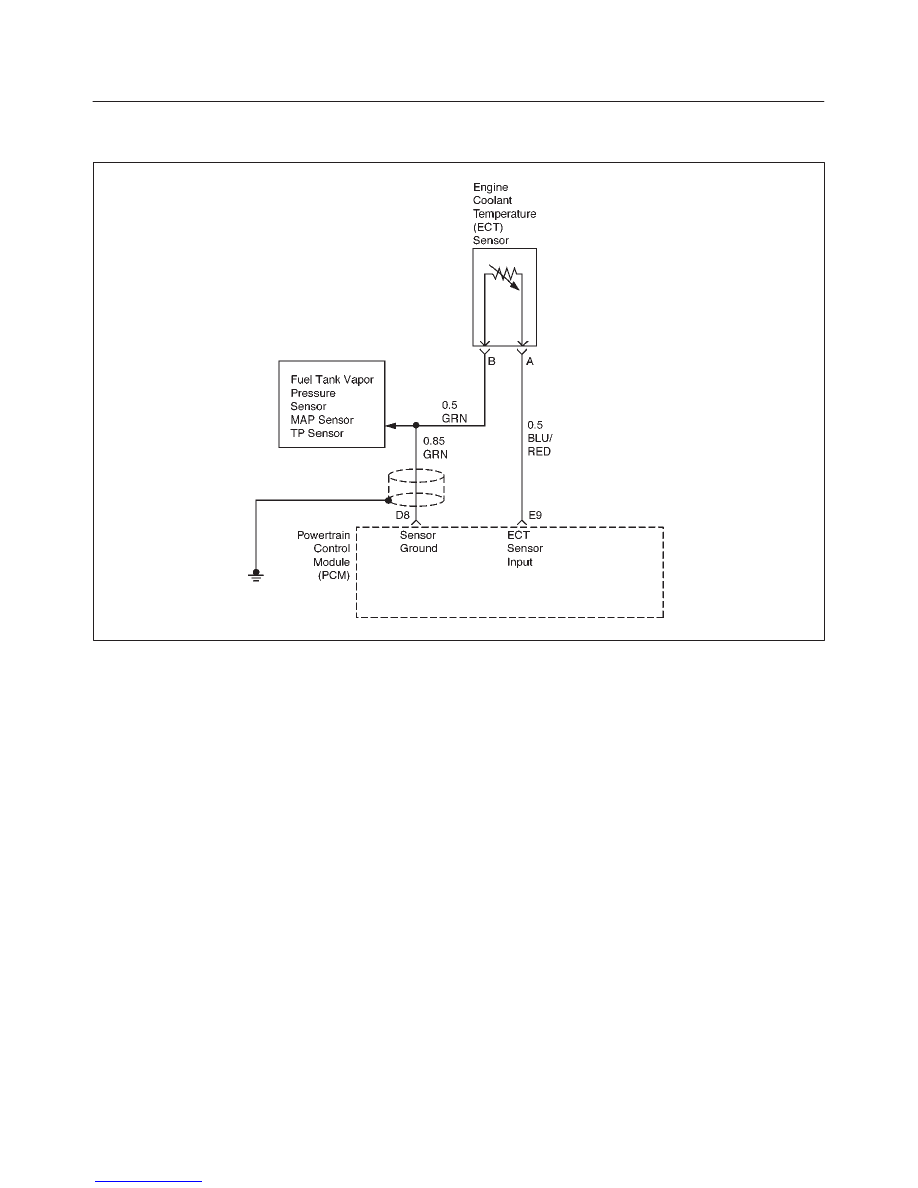Isuzu Rodeo UE. Manual — part 235

6E1–311
RODEO X22SE 2.2L ENGINE DRIVEABILITY AND EMISSION
DIAGNOSTIC TROUBLE CODE (DTC) P1114 ENGINE COOLANT
TEMPERATURE (ECT) SENSOR CIRCUIT INTERMITTENT LOW VOLTAGE
D06RX044
Circuit Description
The engine coolant temperature (ECT) sensor is a
thermistor mounted in the engine coolant stream. The
powertrain control module (PCM) applies a voltage
(about 5.0 volts) through a pull–up resistor to the ECT
signal circuit. When the engine coolant is cold, the sensor
(thermistor) resistance is high, therefore the PCM will
measure a high signal voltage. As the engine coolant
warms, the sensor resistance becomes less, and the
ECT signal voltage measured at the PCM drops. With a
fully warmed up engine, the ECT signal voltage should
measure about 1.5 to 2.0 volts. If the PCM detects an
ECT signal that is intermittently below the range of the
ECT sensor, Diagnostic Trouble Code P1114 will set.
DTC P1114 is a type D code.
Conditions for Setting the DTC
f
Engine run time longer than 2 minutes.
f
The ECT sensor signal is intermittently greater than
150
°
C (302
°
F) (about 0.10 volt) for a total of 10
seconds over a 100–second period.
Action Taken When the DTC Sets
f
The PCM will not illuminate the malfunction indicator
lamp (MIL).
f
The PCM will store conditions which were present
when the Diagnostic Trouble Code set as Failure
Records data only. This information will not be stored
as Freeze Frame data.
Conditions for Clearing the DTC
f
A history Diagnostic Trouble Code P1114 will clear
after 40 consecutive warm–up cycles have occurred
without a fault.
f
Diagnostic Trouble Code P1114 can be cleared by
using the Scan Tool’s ”Clear Info” function.
Diagnostic Aids
Check for the following conditions:
f
Poor connection at PCM – Inspect harness connectors
for backed–out terminals, improper mating, broken
locks, improperly formed or damaged terminals, and
poor terminal–to–wire connection.
f
Damaged harness – Inspect the wiring harness for
damage; shorts to ground, shorts to battery positive,
and open circuits. If the harness appears to be OK,
observe the ECT display on the Tech 2 while moving
connectors and wiring harnesses related to the ECT
sensor. A change in the ECT display will indicate the
location of the fault.
Reviewing the Failure Records vehicle mileage since the
diagnostic test last failed may help determine how often
the condition that caused the Diagnostic Trouble Code to
be set occurs. This may assist in diagnosing the
condition.

6E1–312
RODEO X22SE 2.2L ENGINE DRIVEABILITY AND EMISSION
Engine Coolant Temperature Sensor
°
C
°
F
W
Temperature vs. Resistance Values (approximate)
100
212
177
80
176
332
60
140
667
45
113
1188
35
95
1802
25
77
2796
15
59
4450
5
41
7280
–5
23
12300
–15
5
21450
–30
–22
52700
–40
–40
100700
DTC P1114 – ECT Sensor Circuit Intermittent Low Voltage
Step
Action
Value(s)
Yes
No
1
Was the ”On–Board Diagnostic (OBD) System Check”
performed?
—
Go to Step 2
Go to OBD
System
Check
2
Is DTC P0117 also set?
—
Go to DTC
P0117 first
Go to Step 3
3
1. Check the ECT signal circuit between the ECT
sensor connector and the PCM for an intermittent
short to ground.
2. If a problem is found, repair as necessary.
Was a problem found?
—
Verify repair
Refer to
Diagnostic
Aids

6E1–313
RODEO X22SE 2.2L ENGINE DRIVEABILITY AND EMISSION
DIAGNOSTIC TROUBLE CODE (DTC) P1115 ENGINE COOLANT
TEMPERATURE (ECT) SENSOR CIRCUIT INTERMITTENT HIGH VOLTAGE
D06RX044
Circuit Description
The engine coolant temperature (ECT) sensor is a
thermistor mounted in the engine coolant stream. The
powertrain control module (PCM) applies a voltage
(about 5.0 volts) through a pull–up resistor to the ECT
signal circuit. When the engine coolant is cold, the sensor
(thermistor) resistance is high, therefore the PCM will
measure a high signal voltage. As the engine coolant
warms, the sensor resistance becomes less, and the
ECT signal voltage measured at the PCM drops. With a
fully warmed up engine, the ECT signal voltage should
measure about 1.5 to 2.0 volts. If the PCM detects an
ECT signal that is intermittently above the range of the
ECT sensor, Diagnostic Trouble Code P1115 will set.
Diagnostic Trouble Code P1115 is a type D code.
Conditions for Setting the DTC
f
Engine run time longer than 180 seconds.
f
The ECT sensor signal is intermittently greater than
–39
°
C (–38
°
F) (4.94 volts) for a total of 10 seconds
over a 100–second period.
Action Taken When the DTC Sets
f
The PCM will not illuminate the malfunction indicator
lamp (MIL).
f
The PCM will store conditions which were present
when the Diagnostic Trouble Code set as Failure
Records data only. This information will not be stored
as Freeze Frame data.
Conditions for Clearing the DTC
f
A history Diagnostic Trouble Code P1115 will clear
after 40 consecutive warm–up cycles have occurred
without a fault.
f
Diagnostic Trouble Code P1115 can be cleared by
using the Scan Tool’s ”Clear Info” function.
Diagnostic Aids
Check for the following conditions:
f
Poor connection at PCM – Inspect harness connectors
for backed–out terminals, improper mating, broken
locks, improperly formed or damaged terminals, and
poor terminal–to–wire connection.
f
Damaged harness – Inspect the wiring harness for
damage; shorts to ground, shorts to battery positive,
and open circuits. If the harness appears to be OK,
observe the ECT display on the Tech 2 while moving
connectors and wiring harnesses related to the ECT
sensor. A change in the ECT display will indicate the
location of the fault.
Reviewing the Failure Records vehicle mileage since the
diagnostic test last failed may help determine how often
the condition that caused the Diagnostic Trouble Code to
be set occurs. This may assist in diagnosing the
condition.

6E1–314
RODEO X22SE 2.2L ENGINE DRIVEABILITY AND EMISSION
Engine Coolant Temperature Sensor
°
C
°
F
W
Temperature vs. Resistance Values (approximate)
100
212
177
80
176
332
60
140
667
45
113
1188
35
95
1802
25
77
2796
15
59
4450
5
41
7280
–5
23
12300
–15
5
21450
–30
–22
52700
–40
–40
100700

Нет комментариевНе стесняйтесь поделиться с нами вашим ценным мнением.
Текст